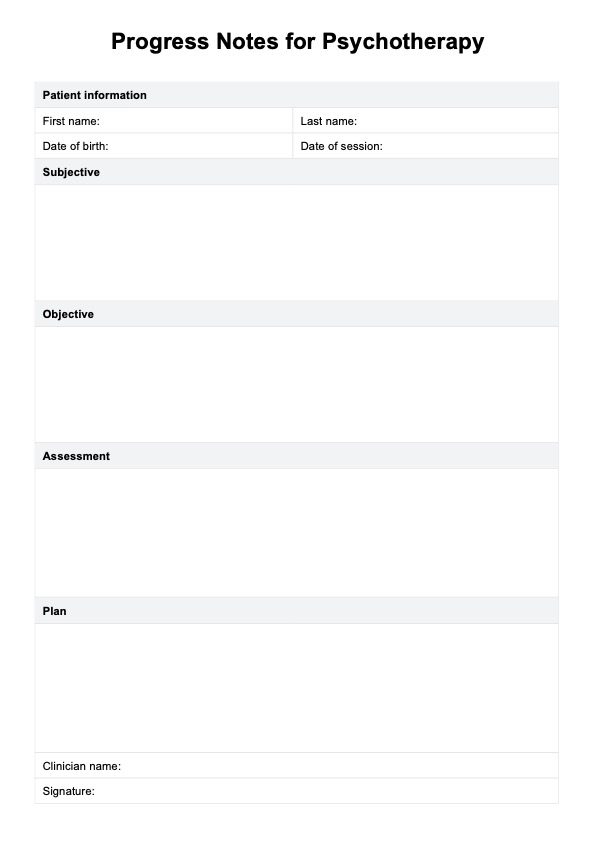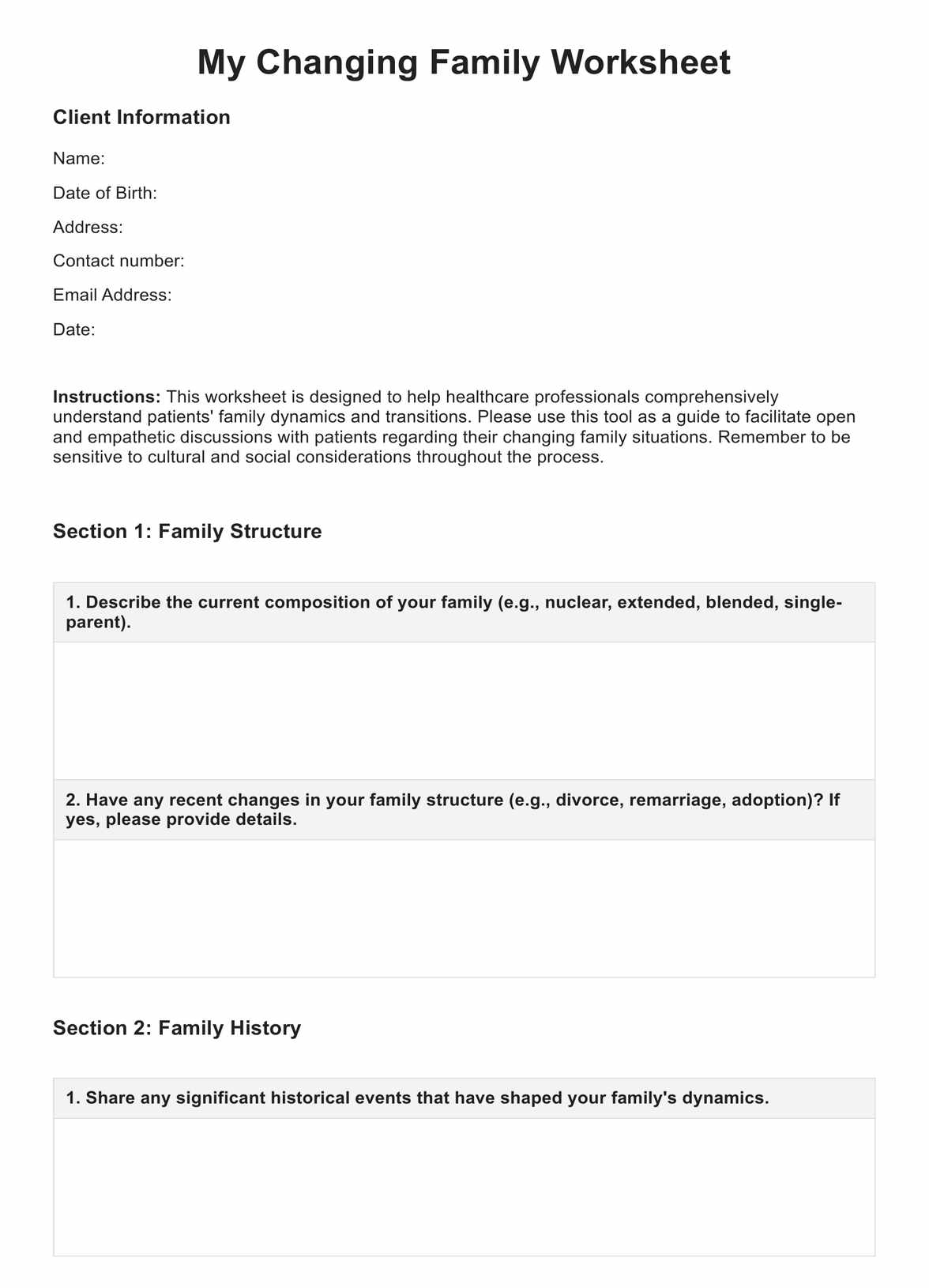Wheel of Feelings Template
Enhance healthcare communication with our Wheel of Feelings Template—facilitating empathy and understanding in patient interactions.


Introducing the Wheel of Feelings
Unlock a new dimension in patient care with the innovative Wheel of Feelings—a powerful tool designed to enhance emotional intelligence and communication within healthcare settings. As healthcare practitioners at the forefront of patient well-being, incorporating the feelings wheel into your practice can significantly elevate the quality of care and deepen patient-provider relationships.
The Wheel of Feelings, also known as the feelings wheel, is a comprehensive guide to understanding primary, secondary, and tertiary emotions and the intricate nuances of emotional responses. This tool empowers healthcare professionals with a structured approach to navigating complex emotional landscapes, fostering a deeper connection with patients.
The Wheel of Feelings is a valuable resource for identifying and addressing uncomfortable emotions in mental health. By expanding emotional vocabulary and promoting emotional awareness, practitioners can skillfully guide patients through their emotional journeys, ultimately contributing to improved mental well-being.
This tool is particularly beneficial for delving into secondary emotions, shedding light on the layers beneath surface-level feelings. By recognizing and addressing these secondary feelings, healthcare practitioners can provide more targeted and personalized care, ensuring a holistic approach to emotional health.
As advocates for comprehensive patient care, we understand the significance of emotional intelligence in the healthcare environment. The Wheel of Feelings is not merely a chart but a dynamic instrument that facilitates constructive conversations, enabling healthcare practitioners to navigate the intricate terrain of core feelings and constructed emotions.
In your transactional analysis journal, integrate the Wheel of Feelings to elevate your practice and better understand the emotional dynamics in patient interactions. This tool is valuable for healthcare practitioners committed to creating a supportive and empathetic environment, promoting mental health and well-being.
Enhance your patient care journey with the Wheel of Feelings—a catalyst for positive change and heightened emotional intelligence in healthcare practice.
Wheel of Feelings Template
Wheel of Feelings Template Example
How does the Feelings Wheel work?
The Feelings Wheel, often regarded as a powerful tool in emotional intelligence and psychotherapy, facilitates a nuanced understanding of emotions. Developed to delve beyond basic emotional states, this wheel aids individuals in identifying and articulating a spectrum of feelings, fostering self-awareness and enhancing communication skills.
Identification of primary emotions
At the core of the Feelings Wheel are the primary emotions—basic feelings such as joy, sadness, anger, fear, surprise, and disgust. These serve as the foundation for further exploration.
Secondary and tertiary emotions
Beyond the primary ones, the wheel branches into secondary and tertiary emotions. For instance, one might find grief, disappointment, or loneliness under sadness. This categorization allows individuals to pinpoint more specific and nuanced feelings.
Psychorevolutionary synthesis
The Feelings Wheel draws on concepts from psychorevolutionary synthesis, a theory rooted in gestalt therapy. This approach, popularized in vintage books on psychology, posits that understanding complex emotions involves recognizing the interplay between primary and derived feelings.
Prefrontal cortex engagement
Engaging with the Feelings Wheel stimulates the prefrontal cortex, the brain region associated with decision-making and emotional regulation. Individuals can consciously navigate and manage their emotional responses by involvement.
Communication enhancement
The wheel is a valuable aid in improving intrapersonal and interpersonal communication. By having a vocabulary that extends beyond broad terms like "happy" or "sad," individuals can articulate their emotions more precisely, fostering a deeper connection with others.
Moment-by-moment application
In real-time, the Feelings Wheel serves as a guide for identifying emotions in the moment. Individuals can reference the wheel to understand their emotional state better in therapy, daily reflection, or stress management.
Filling the Form:
Identify the dominant emotion
Begin by identifying the primary emotion that resonates most with your current state, such as joy or sadness.
Explore layers
Delve deeper into the secondary and tertiary emotions associated with the primary one. This exploration helps unveil the layers of complexity in your emotional experience.
Utilize Gestalt therapy principles
Apply principles from Gestalt therapy by considering the holistic picture of your emotional landscape and acknowledging how various feelings interconnect.
Communicate effectively
Armed with a more comprehensive emotional vocabulary, communicate your feelings more effectively with others, leading to more meaningful connections.
The Feelings Wheel is a dynamic instrument for emotional exploration, empowering individuals to identify, understand, and communicate their emotions with greater precision and depth.
Benefits of the Feelings Wheel
The Feelings Wheel is a valuable and versatile tool for enhancing emotional intelligence and communication. Here are six key benefits of using this worksheet:
Identification and articulation
The wheel provides a structured framework to identify and articulate a broad spectrum of emotions, from primary ones like joy to more complex feelings like melancholy.
Nuanced emotional exploration
With its psychorevolutionary synthesis foundation, the wheel allows individuals to explore emotions beyond basic categories, providing insights into the layers of complex feelings.
Communication enhancement
It facilitates effective communication by expanding emotional vocabulary, enabling individuals to express themselves more accurately and positively.
Stress and anxiety management
The tool assists in stress and anxiety management by fostering self-awareness. Individuals can use it to pinpoint the sources of stress and anxiety and explore healthier coping mechanisms.
Relationship insight
Utilizing the wheel in the context of relationships promotes a deeper understanding of one's emotions and those of others, fostering empathy and positive interactions.
Positive emotional response
Individuals can respond more effectively to intense emotions by using the wheel, transforming overwhelming or negative feelings into constructive and joyful experiences.
In these two main ways—by expanding the emotional vocabulary and providing a nuanced exploration—the Feelings Wheel becomes an indispensable tool for individuals seeking to enhance their emotional awareness, manage stress, and communicate effectively within various facets of life.
Commonly asked questions
The wheel enhances emotional awareness, communication, and self-reflection. It allows individuals to delve beyond basic emotions, fostering a deeper understanding of their emotional landscape.
Yes, many therapists incorporate the wheel into their practice to facilitate discussions about emotions, improve communication, and support clients in exploring their feelings.
While there are no strict rules, users are encouraged to identify their primary emotions and explore the associated secondary and tertiary feelings. It's a tool for self-reflection and emotional exploration.


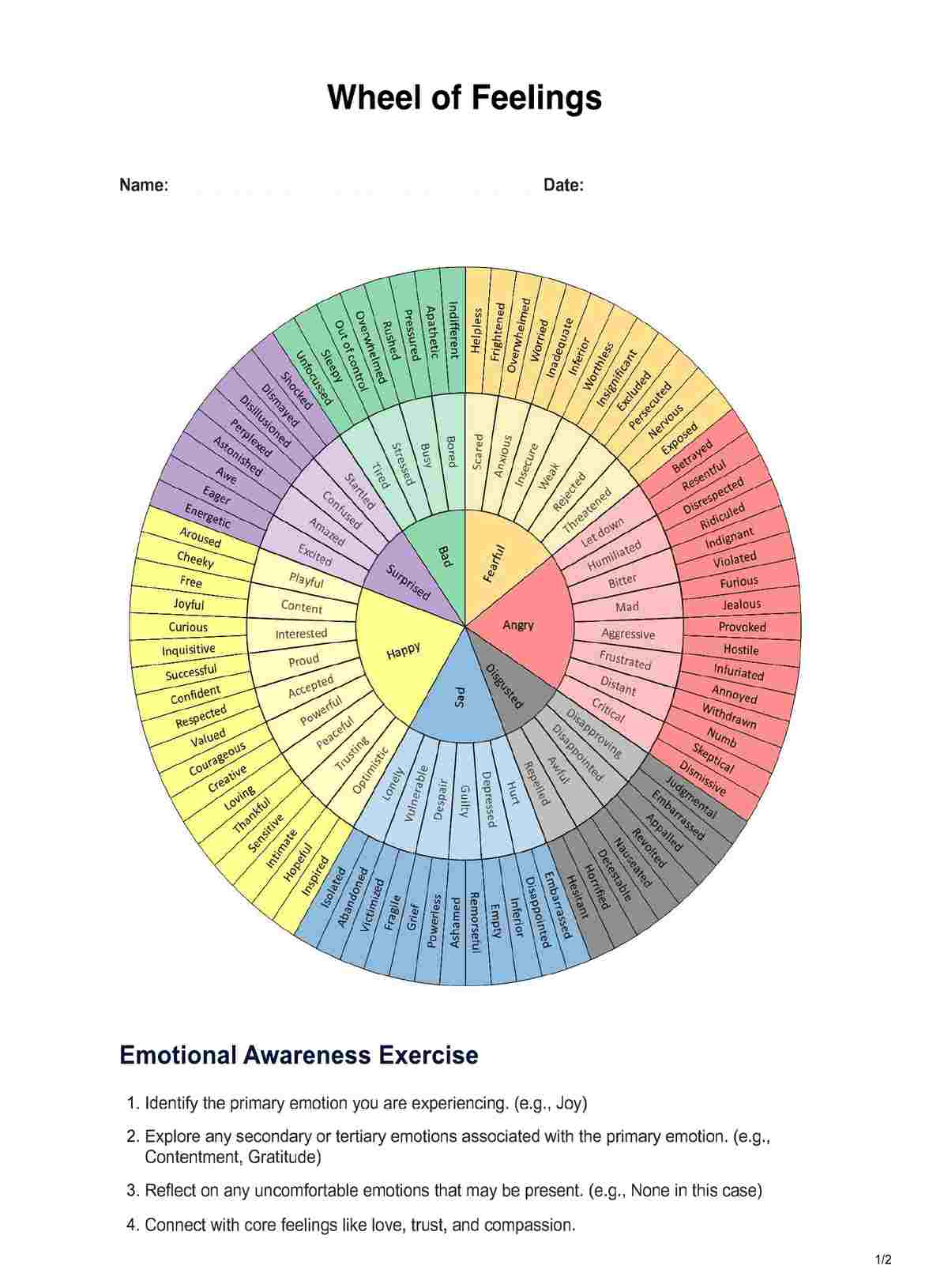
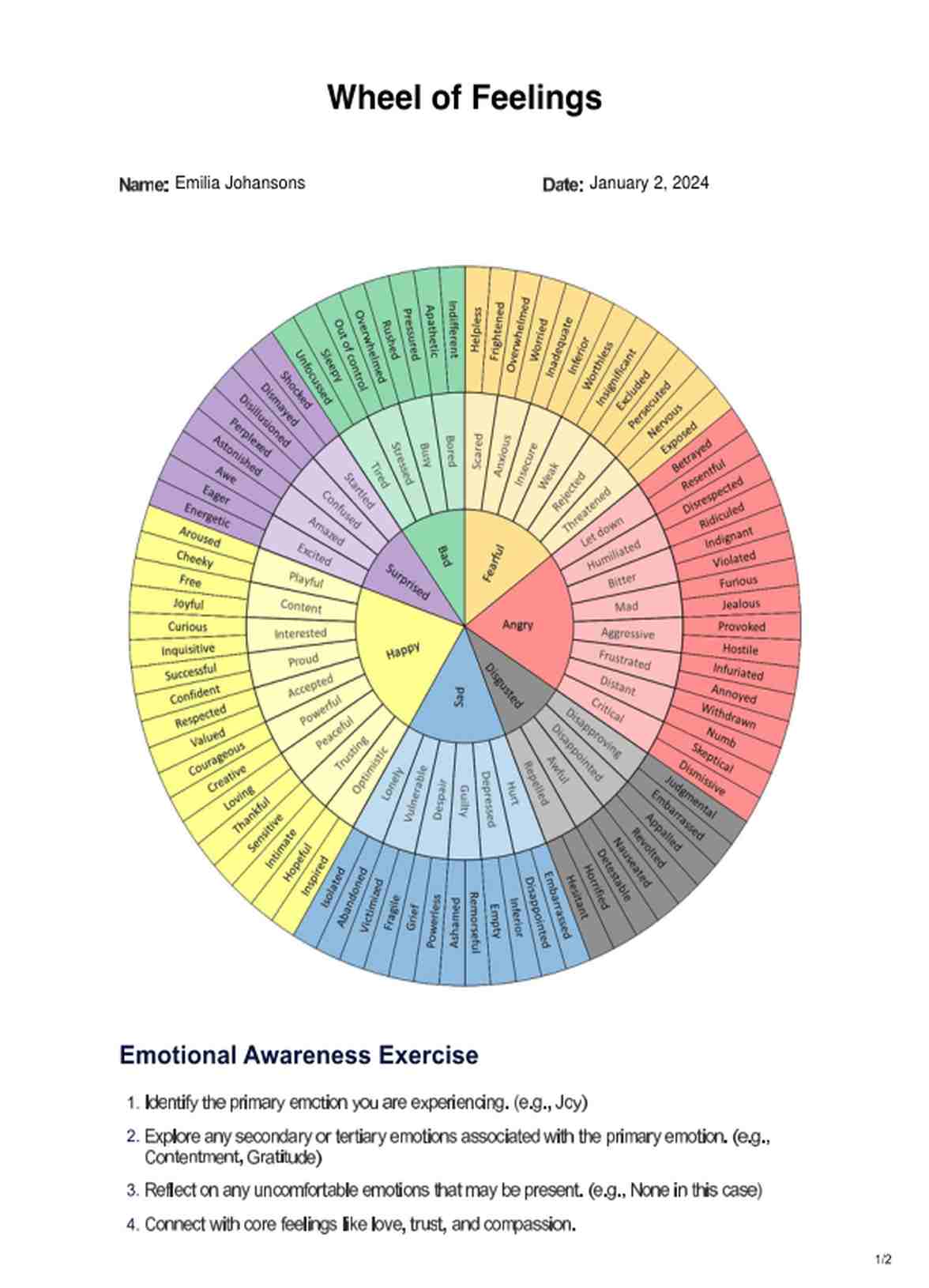


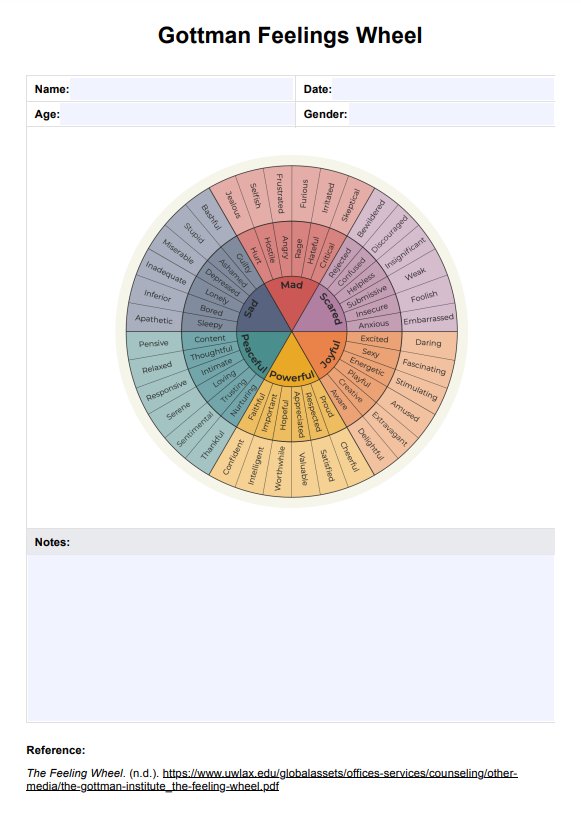
















-template.jpg)

























































































